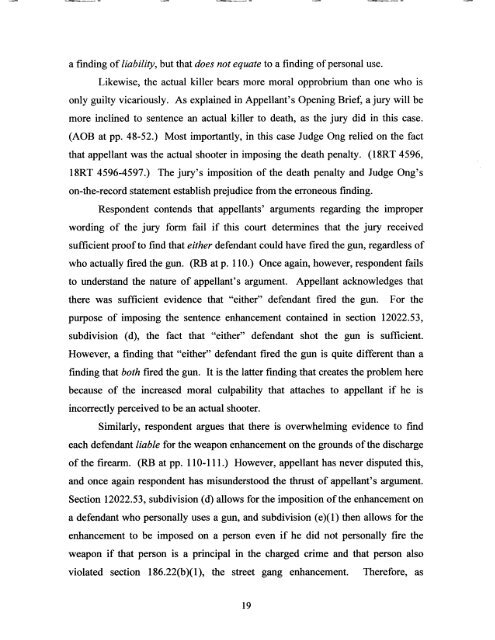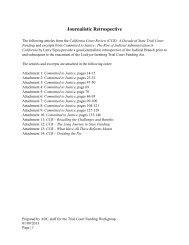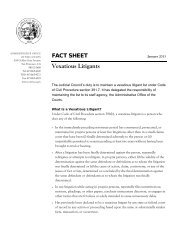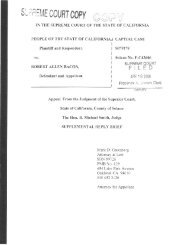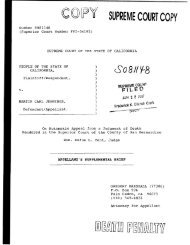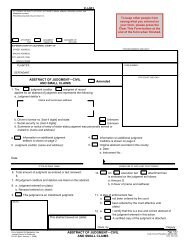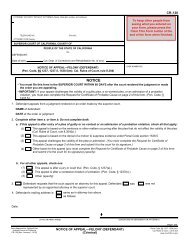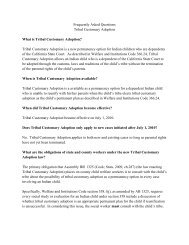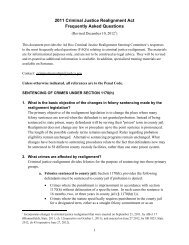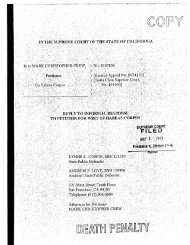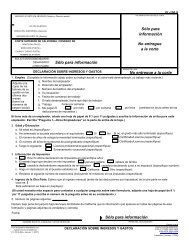Appellant, William Satele, Reply Brief - California Courts - State of ...
Appellant, William Satele, Reply Brief - California Courts - State of ...
Appellant, William Satele, Reply Brief - California Courts - State of ...
You also want an ePaper? Increase the reach of your titles
YUMPU automatically turns print PDFs into web optimized ePapers that Google loves.
a finding <strong>of</strong>liability, but that does not equate to a finding <strong>of</strong>personal use.<br />
Likewise, the actual killer bears more moral opprobrium than one who is<br />
only guilty vicariously. As explained in <strong>Appellant</strong>'s Opening <strong>Brief</strong>, a jury will be<br />
more inclined to sentence an actual killer to death, as the jury did in this case.<br />
(AOB at pp. 48-52.) Most importantly, in this case Judge Ong relied on the fact<br />
that appellant was the actual shooter in imposing the death penalty. (18RT 4596,<br />
18RT 4596-4597.) The jury's imposition <strong>of</strong> the death penalty and Judge Ong's<br />
on-the-record statement establish prejudice from the erroneous finding.<br />
Respondent contends that appellants' arguments regarding the Improper<br />
wording <strong>of</strong> the jury form fail if this court determines that the jury received<br />
sufficient pro<strong>of</strong>to find that either defendant could have fired the gun, regardless <strong>of</strong><br />
who actually fired the gun. (RB at p. 110.) Once again, however, respondent fails<br />
to understand the nature <strong>of</strong> appellant's argument. <strong>Appellant</strong> acknowledges that<br />
there was sufficient evidence that "either" defendant fired the gun. For the<br />
purpose <strong>of</strong> imposing the sentence enhancement contained in section 12022.53,<br />
subdivision (d), the fact that "either" defendant shot the gun is sufficient.<br />
However, a finding that "either" defendant fired the gun is quite different than a<br />
finding that both fired the gun. It is the latter finding that creates the problem here<br />
because <strong>of</strong> the increased moral culpability that attaches to appellant if he IS<br />
incorrectly perceived to be an actual shooter.<br />
Similarly, respondent argues that there is overwhelming evidence to find<br />
each defendant liable for the weapon enhancement on the grounds <strong>of</strong>the discharge<br />
<strong>of</strong> the firearm. (RB at pp. 110-111.) However, appellant has never disputed this,<br />
and once again respondent has misunderstood the thrust <strong>of</strong> appellant's argument.<br />
Section 12022.53, subdivision (d) allows for the imposition <strong>of</strong>the enhancement on<br />
a defendant who personally uses a gun, and subdivision (e)(1) then allows for the<br />
enhancement to be imposed on a person even if he did not personally fire the<br />
weapon if that person is a principal in the charged crime and that person also<br />
violated section 186.22(b)(1), the street gang enhancement. Therefore, as<br />
19


